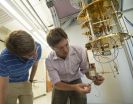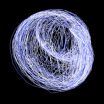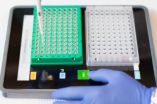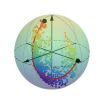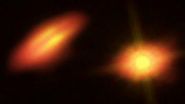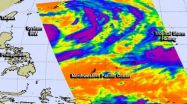(Press-News.org) Groundskeepers and landscapers hate them, but there is no fighting them. Called desire paths, social trails or goat tracks, they are the unofficial shortcuts people create between two locations when the purpose-built path doesn't take them where they want to go.
There's a similar concept in classical physics called the "path of least action." If you throw a softball to a friend, the ball traces a parabola through space. It doesn't follow a serpentine path or loop the loop because those paths have higher "actions" than the true path.
But what paths do quantum particles, such as atoms or photons, follow? For these particles, the laws of classical physics cease to apply, and quantum physics and its counterintuitive effects takes over.
Quantum particles can exist in a superposition of states, yet as soon as quantum particles are "touched" by the outside world, they lose this quantum strangeness and collapse to a classically permitted state. Because of this evasiveness, it wasn't possible until recently to observe them in their quantum state.
But in the past 20 years, physicists have devised devices that isolate quantum systems from the environment and allow them to be probed so gently that they don't immediately collapse. With these devices, scientists can at long last follow quantum systems into quantum territory, or state space.
Kater Murch, PhD, an assistant professor of physics at Washington University in St. Louis, and collaborators Steven Weber and Irfan Siddiqui of the Quantum Nanoelectronics Laboratory at the University of California, Berkeley, have used a superconducting quantum device to continuously record the tremulous paths a quantum system took between a superposition of states to one of two classically permitted states.
Because even gentle probing makes each quantum trajectory noisy, Murch's team repeated the experiment a million times and examined which paths were most common. The quantum equivalent of the classical "least action" path — or the quantum device's path of desire — emerged from the resulting cobweb of many paths, just as pedestrian desire paths gradually emerge after new sod is laid.
The experiments, the first continuous measurements of the trajectories of a quantum system between two points, are described in the cover article of the July 31 issue of Nature.
"We are working with the simplest possible quantum system," Murch said. "But the understanding of quantum interactions we are gaining might eventually be useful for the quantum control of biological and chemical systems.
"Chemistry at its most basic level is described by quantum mechanics," he said. "In the past 20 years, chemists have developed a technique called quantum control, where shaped laser pulses are used to drive chemical reactions — that is, to drive them between two quantum states. The chemists control the quantum field from the laser, and that field controls the dynamics of a reaction," he said.
"Eventually, we'll be able to control the dynamics of chemical reactions with lasers instead of just mixing reactant 1 with reactant 2 and letting the reaction evolve on its own," he said.
An artificial atom
The device Murch uses to explore quantum space is a simple superconducting circuit. Because it has quantized energy levels, or states, like an atom, it is sometimes called an artificial atom. Murch's team uses the bottom two energy levels, the ground state and an excited state, as their model quantum system.
Between these two states, there are an infinite number of quantum states that are superpositions, or combinations, of the ground and excited states. In the past, these states would have been invisible to physicists because attempts to measure them would have caused the system to immediately collapse.
But Murch's device allows the system's state to be probed many times before it becomes an effectively classical system. The quantum state of the circuit is detected by putting it inside a microwave box. A very small number of microwave photons are sent into the box where their quantum fields interact with the superconducting circuit.
The microwaves are so far off resonance with the circuit that they cannot drive it between its ground and its excited state. So instead of being absorbed, they leave the box bearing information about the quantum system in the form of a phase shift (the position of the troughs and peaks of the photons' wavefunctions).
Although there is information about the quantum system in the exiting microwaves, it is only a small amount of information.
"Every time we nudge the system, something different happens," Murch said. "That's because the photons we use to measure the quantum system are quantum mechanical as well and exhibit quantum fluctuations. So it takes many of these measurements to distinguish the system's signal from the quantum fluctuations of the photons probing it." Or, as physicists put it, these are weak measurements.
Murch compares these experiments to soccer matches, which are ultimately experiments to determine which team is better. But because so few goals are scored in soccer, and these are often lucky shots, the less skilled team has a good chance of winning. Or as Murch might put it, one soccer match is such a weak measurement of a team's skill that it can't be used to draw a statistically reliable conclusion about which team is more skilled.
Each time a team scores a goal, it becomes somewhat more likely that that team is the better team, but the teams would have to play many games or play for a very long time to know for sure. These fluctuations are what make soccer matches so exciting.
Murch is in essence able to observe millions of these matches, and from all the matches where team B wins, he can determine the most likely way a game that ends with a victory for team B will develop.
A line of desire
So what is the most likely path for a quantum system slowly collapsing from a superposition of states to one of two final states?
"Before we started this experiment," Murch said, " I asked everybody in the lab what they thought the most likely path between quantum states would be. I drew a couple of options on the board: a straight line, a convex curve, a concave curve, a squiggly line . . . I took a poll, and we all guessed different options. Here we were, a bunch of quantum experts, and we had absolutely no intuition about the most likely path."
Andrew N. Jordan of the University of Rochester and his students Areeya Chantasri and Justin Dressel inspired the study by devising a theory to predict the likely path. Their theory predicted that a convex curve Murch had drawn on the white board would be the correct path.
"When we looked at the data, we saw that the theorists were right. Our very clever collaborators had devised a 'principle of least action' that works in the quantum case," Murch said.
They had found the quantum system's line of desire mathematically and by calculation before many microwave photons trampled out the path in Murch's lab.
But as the famous physicist Richard Feynman once said, "It doesn't matter how beautiful your theory is, it doesn't matter how smart you are. If it doesn't agree with experiment, it's wrong." And he was a theoretician.
INFORMATION: END
Finding quantum lines of desire
Physicists have tracked a quantum system's wanderings through quantum state space, a feat once considered impossible
2014-07-30
ELSE PRESS RELEASES FROM THIS DATE:
Tidal forces gave moon its shape, according to new analysis
2014-07-30
The shape of the moon deviates from a simple sphere in ways that scientists have struggled to explain. A new study by researchers at UC Santa Cruz shows that most of the moon's overall shape can be explained by taking into account tidal effects acting early in the moon's history.
The results, published July 30 in Nature, provide insights into the moon's early history, its orbital evolution, and its current orientation in the sky, according to lead author Ian Garrick-Bethell, assistant professor of Earth and planetary sciences at UC Santa Cruz.
As the moon cooled and ...
Target growth-driving cells within tumors, not fastest-proliferating cells
2014-07-30
BOSTON –– Of the many sub-groups of cells jockeying for supremacy within a cancerous tumor, the most dangerous may not be those that can proliferate the fastest, researchers at Dana-Farber Cancer Institute report in a paper appearing in an advance online publication of the journal Nature. The findings have important implications for the treatment of cancer with precision medicines, the study authors explained: Doctors need to ascertain which cell subgroups are truly driving the tumor's growth and metastasis and select drugs that target the critical genes within those cells. ...
ALMA finds double star with weird and wild planet-forming discs
2014-07-30
BOWLING GREEN, O.—From movies to television, obesity is still considered "fair game" for jokes and ridicule. A new study from researchers at Bowling Green State University took a closer look at weight-related humor to see if anti-fat attitudes played into a person's appreciation or distaste for fat humor in the media.
"Weight-Related Humor in the Media: Appreciation, Distaste and Anti-Fat Attitudes," by psychology Ph.D. candidate Jacob Burmeister and Dr. Robert Carels, professor of psychology, is featured in the June issue of Psychology of Popular Media Culture.
Carels ...
Innovative scientists update old-school pipetting with new-age technology
2014-07-30
CAMBRIDGE, Mass. (July 30, 2014) A team of Whitehead Institute researchers is bringing new levels of efficiency and accuracy to one of the most essential albeit tedious tasks of bench science: pipetting. And, in an effort to aid the scientific community at large, the group has established an open source system that enables anyone to benefit from this development free of charge.
Dubbed "iPipet," the system converts an iPad or any tablet computer into a "smart bench" that guides the execution of complex pipetting protocols. iPipet users can also share their pipetting designs ...
Mapping the optimal route between 2 quantum states
2014-07-30
As a quantum state collapses from a quantum superposition to a classical state or a different superposition, it will follow a path known as a quantum trajectory. For each start and end state there is an optimal or "most likely" path, but it is not as easy to predict the path or track it experimentally as a straight-line between two points would be in our everyday, classical world.
In a new paper featured this week on the cover of Nature, scientists from the University of Rochester, University of California at Berkeley and Washington University in St. Louis have shown ...
Young binary star system may form planets with weird and wild orbits
2014-07-30
Unlike our solitary Sun, most stars form in binary pairs -- two stars that orbit a common center of mass. Though remarkably plentiful, binaries pose a number of questions, including how and where planets form in such complex environments.
While surveying a series of binary stars with the Atacama Large Millimeter/submillimeter Array (ALMA), astronomers uncovered a striking pair of wildly misaligned planet-forming disks in the young binary star system HK Tau. These results provide the clearest picture ever of protoplanetary disks around a double star and could reveal important ...
Scientists reproduce evolutionary changes by manipulating embryonic development of mice
2014-07-30
A group of researchers from the University of Helsinki and the Universitat Autònoma de Barcelona have been able experimentally to reproduce in mice morphological changes which have taken millions of years to occur. Through small and gradual modifications in the embryonic development of mice teeth, induced in the laboratory, scientists have obtained teeth which morphologically are very similar to those observed in the fossil registry of rodent species which separated from mice millions of years ago.
To modify the development of their teeth, the team from the Institute ...
Conservation scientists asking wrong questions on climate change impacts on wildlife
2014-07-30
Scientists studying the potential effects of climate change on the world's animal and plant species are focusing on the wrong factors, according to a new paper by a research team from the Wildlife Conservation Society, University of Queensland, and other organizations. The authors claim that most of the conservation science is missing the point when it comes to climate change.
While the majority of climate change scientists focus on the "direct" threats of changing temperatures and precipitation after 2031, far fewer researchers are studying how short-term human adaptation ...
Antarctic ice sheet is result of CO2 decrease, not continental breakup
2014-07-30
DURHAM, N.H. – Climate modelers from the University of New Hampshire have shown that the most likely explanation for the initiation of Antarctic glaciation during a major climate shift 34 million years ago was decreased carbon dioxide (CO2) levels. The finding counters a 40-year-old theory suggesting massive rearrangements of Earth's continents caused global cooling and the abrupt formation of the Antarctic ice sheet. It will provide scientists insight into the climate change implications of current rising global CO2 levels.
In a paper published today in Nature, Matthew ...
NASA catches two tropical troublemakers in Northwestern Pacific: Halong and 96W
2014-07-30
There are two tropical low pressure areas in the Northwestern Pacific Ocean today and they're close enough to each other to be captured in one image generated from data gathered by NASA's Aqua satellite.
NASA's Aqua satellite flew over both Tropical Storm Halong and developing System 96W early on July 30 and the Atmospheric Infrared Sounder (AIRS) instrument captured infrared data on them in one image. Both systems show powerful thunderstorms stretching high into the troposphere with cloud top temperatures as cold as -63F/-52C. Those thunderstorms have the potential for ...
LAST 30 PRESS RELEASES:
Numbers in our sights affect how we perceive space
SIMJ announces global collaborative book project in commemoration of its 75th anniversary
Air pollution exposure and birth weight
Obstructive sleep apnea risk and mental health conditions among older adults
How talking slows eye movements behind the wheel
The Ceramic Society of Japan’s Oxoate Ceramics Research Association launches new international book project
Heart-brain connection: international study reveals the role of the vagus nerve in keeping the heart young
Researchers identify Rb1 as a predictive biomarker for a new therapeutic strategy in some breast cancers
Survey reveals ethical gaps slowing AI adoption in pediatric surgery
Stimulant ADHD medications work differently than thought
AI overestimates how smart people are, according to HSE economists
HSE researchers create genome-wide map of quadruplexes
Scientists boost cell "powerhouses" to burn more calories
Automatic label checking: The missing step in making reliable medical AI
Low daily alcohol intake linked to 50% heightened mouth cancer risk in India
American Meteorological Society announces Rick Spinrad as 2026 President-Elect
Biomass-based carbon capture spotlighted in newly released global climate webinar recording
Illuminating invisible nano pollutants: advanced bioimaging tracks the full journey of emerging nanoscale contaminants in living systems
How does age affect recovery from spinal cord injury?
Novel AI tool offers prognosis for patients with head and neck cancer
Fathers’ microplastic exposure tied to their children’s metabolic problems
Research validates laboratory model for studying high-grade serous ovarian cancer
SIR 2026 delivers transformative breakthroughs in minimally invasive medicine to improve patient care
Stem Cell Reports most downloaded papers of 2025 highlight the breadth and impact of stem cell research
Oxford-led study estimates NHS spends around 3% of its primary and secondary care budget on the health impacts of heat and cold in England
A researcher’s long quest leads to a smart composite breakthrough
Urban wild bees act as “microbial sensors” of city health.
New study finds where you live affects recovery after a hip fracture
Forecasting the impact of fully automated vehicle adoption on US road traffic injuries
Alcohol-related hospitalizations from 2016 to 2022
[Press-News.org] Finding quantum lines of desirePhysicists have tracked a quantum system's wanderings through quantum state space, a feat once considered impossible
